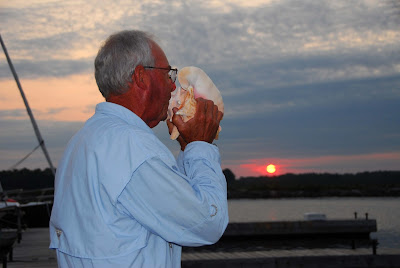. . . In Northern Michigan
It's been a week since we sailed into Michigan. So far, we've island hopped to Drummond where we cleared U.S. Customs, to Mackinac where we were tourists for a day, and to Beaver where we holed up from high winds and waves.
Every year a crew of Chattanooga sailors and friends travel up to Mackinac Island to sail in the Mackinac to Chicago race -- often winning! That race was all we knew about Mackinac Island until now.
Mackinac Island
Fort Mackinac is the major historic site on the island. Built in 1780, it was a strategic link in defense of the Strait of Mackinac and Lake Michigan.
Today the island is a summer resort with more bed-and-breakfast inns per square inch than anywhere we’ve visited. The only way to reach Mackinac Island is by private boat or ferry.
On Mackinac, walkers, bikers and horse-drawn wagons abound. Motor-driven vehicles aren’t allowed. Here, a wagon loaded with boxes passes a tour trolley waiting for passengers.
Mackinaw City
From Mackinac Island, we traveled to Mackinaw City across the Strait. Okay, Mackinaw City isn’t an island, but its residents obviously have the right island attitude. . . "It's Five O'Clock Somewhere" and "No Shoes. No Shirt. No Problem."
Talk like a Michigander
Our Michigan Looper friends, Mike and Gay, on the trawler Irish Attitude, taught us to talk like native Michiganders. For example, UPers are people who live in the Upper Peninsula and regarded as lacking sense by the rest of Michigan. Of course, UPers regard people who live below the Mackinac Bridge as Trolls. We guess that makes us Temporary Trolls, now that we’ve passed below it. And then there’s The Mitt. Michiganders use the palm side of their right hand as a map of their state to point to their home town.
Gold Flag Loopers
Crossing your wake is a bittersweet time. Loopers are happy to finish a long (6,000 miles), sometimes hard trip. Yet Loopers get so absorbed in the adventure that it's sad to see it end.
The sun rose on the UP and the Mackinac Bridge, a 4-mile-long,
135-foot-high bridge over the Strait of Mackinac. It's called The Big Mac here.
Beaver Island
Our latest weather experience has been in winds of 30+ with
gusts of 52 knots (on the anemometer right), with waves of 2 feet – at the dock in St. James Harbor
on Beaver Island.
From Mackinaw City, we had motor sailed to Gray’s Reef. That’s where most Loopers either curve south toward Charlevoix or Petroskey if the winds and waves are favorable, or continue straight to Beaver Island for protection. At Gray’s Reef, trawler friends about five miles ahead who had curved around toward Charlevoix said that the wind and waves had increased. They were occasionally seeing six-foot waves. We decided to tuck into Beaver Island. A weather front moved through, causing the turbulent weather at the dock. It gave us a two-day layover and a chance to get to know this interesting island.
Beaver Island is the largest island in Lake Michigan and can
only be reached through St. James Harbor to the north of the island. Originally
settled a thousand years ago by Native Americans, it was the French who gave
Beaver Island its name in their search for beaver pelts.
After his followers fled or were chased away, Irish immigrants settled on Beaver Island. Irish national flags still fly around St. James Village.
Gaelic sign welcomes visitors to Beaver Island.
Beautiful water, terrible price
 Since Mackinac Island, we’ve admired the clear
water. We thought it was because Michigan and other Great
Lakes states took strong steps to keep it clean. No, it is because of Zebra mussels.
They are an invasive species from Russia that we’re trying to keep out of
southern rivers and lakes.
Since Mackinac Island, we’ve admired the clear
water. We thought it was because Michigan and other Great
Lakes states took strong steps to keep it clean. No, it is because of Zebra mussels.
They are an invasive species from Russia that we’re trying to keep out of
southern rivers and lakes.
Each tiny mussel will filter one gallon of water a
day, eating its nutrients. The result is that fish and other aquatic life
lack the food to flourish. You can see 30 feet down in crystal clear water, but
what you don’t see are fish close to shore.
A Drain on the Great Lakes
The Great Lakes also have to deal with the issue of dropping water levels. Climate change in recent years has brought less snow and that snow melt fills the lakes. Because temperatures are also warmer in the winter, the lakes don't glaze over with ice as they once did. Without that glaze, lake water continues to evaporate all winter. The result is that there are boat houses that are high and dry and stationary docks that require a ladder to get up on from a boat.
Sailing South Again
At Drummond Island, Carina started sailing south again for the
first time since December 15! Because of the weather systems
that can develop on Lake Michigan, we’re moving south at every chance.
Although we're on the go, it looks like we won't meet the Looper timetable in Skipper Bob books. He suggests that Loopers be in Chicago by Labor Day. While we won't make that schedule, we won't be too far behind.
Although we're on the go, it looks like we won't meet the Looper timetable in Skipper Bob books. He suggests that Loopers be in Chicago by Labor Day. While we won't make that schedule, we won't be too far behind.



















































